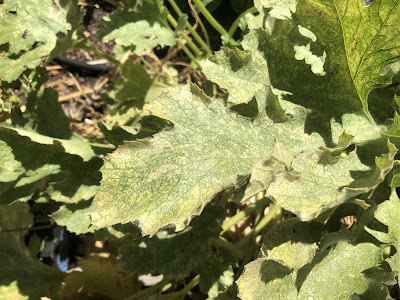

|
|
This zucchini plant is well past its peak, and has
quite a bit of spider mite damage, so it's due to
be removed. (Photo: Kathy Morrison)
|
What a difference a breeze makes! Sacramento’s natural air conditioner, the Delta breeze is back, relieving us (at least briefly) from triple-digit temperatures.
According to the National Weather Service, breezy conditions will keep Sacramento high temperatures in the low 90s at least through Tuesday. But then, the breeze dies down and temperatures spike back up. The forecast calls for highs of 99 degrees Wednesday and Thursday, starting September on a hot note. Overnight lows will stay warm, too: 60 to 64 degrees.
It’s already been a red-hot summer. So far, Sacramento has recorded 34 triple-digit days. Average is 22. Will we set a record? Sacramento broiled with 41 triple-digit days in 1988.
Before temperatures heat up again, take care of some late-summer tasks:
* Prepare for a fall full of flowers by paying a little extra attention to your garden. Cut off spent blooms from roses, annuals and perennials, then give them a boost of fertilizer. Make sure to water plants before feeding. Roses will rebloom about six to eight weeks after deadheading.
* Divide bearded iris and other perennials. Revitalize beds and replant.
*Feed citrus trees their last round of fertilizer for the year. This will give a boost to the fruit that's now forming.
* Camellia leaves looking a little yellow? Feed them some chelated iron. That goes for azaleas and gardenias, too.
* To prolong bloom into fall, feed begonias, fuchsias, annuals and container plants.
* Fertilize fall-blooming perennials, too. Chrysanthemums can be fed until the buds start to open.
* Pick up after your fruit trees. Clean up debris and dropped fruit; this cuts down on insects and prevents the spread of brown rot. Then feed fruit trees with slow-release fertilizer for better production for next year.
* Pull out summer vegetables that are past their prime and have stopped producing. Dispose of plants heavily infested with spider mites.
* Indoors, start seedlings for fall vegetable planting, including bunching onion, cabbage, broccoli, cauliflower, kale, radicchio and lettuce.
* Sow seeds of perennials in pots for fall planting including yarrow, coneflower and salvia.
* In the garden, direct seed beets, carrots, leaf lettuce and turnips.
* Plant more potatoes.
Comments
0 comments have been posted.Sacramento Digs Gardening to your inbox.
Sites We Like
Garden Checklist for week of July 21
Your garden needs you!
* Keep your vegetable garden watered, mulched and weeded. Water before 8 a.m. to reduce the chance of fungal infection and to conserve moisture.
* Feed vegetable plants bone meal, rock phosphate or other fertilizers high in phosphate to stimulate more blooms and fruiting. (But wait until daily high temperatures drop out of the 100s.)
* Don’t let tomatoes wilt or dry out completely. Give tomatoes a deep watering two to three times a week.
* Harvest vegetables promptly to encourage plants to produce more. Squash especially tends to grow rapidly in hot weather. Keep an eye on zucchini.
* Pinch back chrysanthemums for bushy plants and more flowers in September.
* Remove spent flowers from roses, daylilies and other bloomers as they finish flowering.
* Pinch off blooms from basil so the plant will grow more leaves.
* Cut back lavender after flowering to promote a second bloom.
* It's not too late to add a splash of color. Plant petunias, snapdragons, zinnias and marigolds.
* From seed, plant corn, pumpkins, radishes, winter squash and sunflowers.